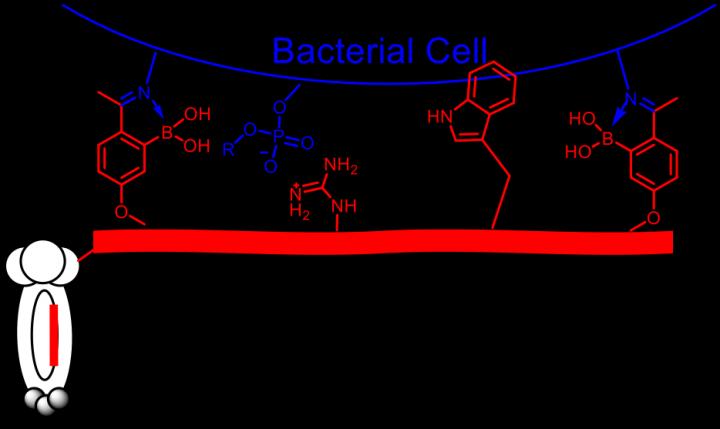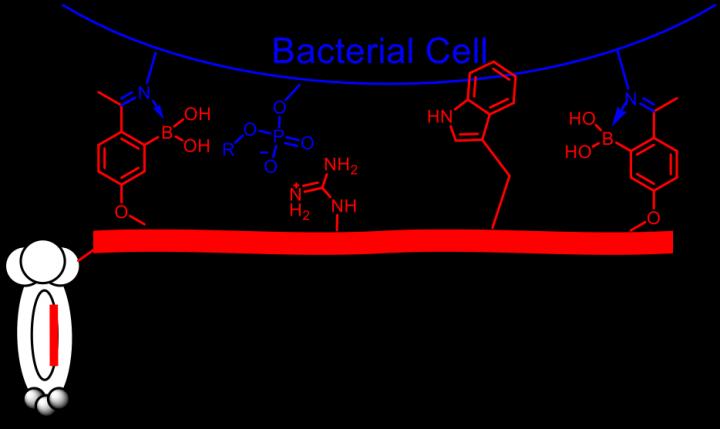
Credit: Journal of the American Chemical Society
Chestnut Hill, Mass. (6/27/2018) – Scientists are searching for ways to develop antibiotics that can accurately target infectious bacteria. Increased specificity could help to combat antibiotic resistance and also spare "good" bacteria from being attacked by broad-spectrum antibiotics.
Efforts to develop targeted antibiotics have been constrained by the difficulty of quick diagnosis and the development of targeted killing mechanisms.
A collaborative effort of two Boston College professors – a chemist and a biologist – has led to a new platform to enable quick discovery of molecules that potentially recognize any strain of bacteria of interest, the team reported recently in the Journal of the American Chemical Society.
The new approach is based on phage display, a proven strategy used to create and screen peptide libraries containing billions of different composite members displayed on bacteriophage. While a powerful tool, phage display has been limited to use with the peptides of natural amino acids, the researchers noted.
Associate Professor of Chemistry Jianmin Gao and Associate Professor of Biology Tim van Opijnen set out to expand the "chemical space" of phage display by incorporating designer chemical warheads that dramatically enhance a peptide's potency to bind biological targets.
Screening of this chemical enhanced library against live bacteria produced powerful, highly-selective probes to target two deadly antibiotic-resistant bacterial pathogens: methicillin-resistant Staphylococcus aureus and colistin-resistant Acinetobacter baumannii, the team reported in an article titled "Phage Display of Dynamic Covalent Binding Motifs Enables Facile Development of Targeted Antibiotics."
Gao said the designer chemical warheads introduce into the phage library a "reversible covalent binding mechanism," which is absent in peptides of natural amino acids. The chemically enhanced peptide library allows potent and selective targeting of a bacterium of interest, overcoming biological conditions that interfere with bonding to pathogens and avoiding healthy human cells.
"The 'warhead' allows us to come up with molecules with enhanced potency and selectivity toward a bacterial strain of interest," said Gao, whose research is supported by the National Institutes of Health. "Now we have a much better library to use for screening and identifying the strains of these specific bacterial molecules."
In further experiments, Gao and van Opijnen successfully attached a generic toxin to these bacterium-targeting molecules, a significant step forward imparting specificity in the treatment of the two strains of bacterium.
"This new, modified phage library shows it can be a powerful, multipurpose tool," said Gao. "First, it can be used to generate imaging agents to confirm a suspected bacterial infection. These probes will go around and look for infected bacteria. Find them and attach to them. Second, we can attach an antibiotic and the probe will serve to deliver the toxin to the only that strain of bacteria. This gets us closer to narrow-spectrum antibiotics."
Gao and van Opijnen said the novel approach should be applicable to a wide range of bacterial pathogens, enabling the development of targeted antibiotics.
"This is a first step toward that long-term goal," said Gao. "We would like to expand this promising approach to develop targeted antibiotics that treat these specific strains of deadly and damaging pathogens."
Gao said advances in targeted antibiotics will improve patient care, and reduce the "strain" placed on necessary bacteria and their evolution of antibiotic resistance.
"With treatment from broad-spectrum antibiotics, all bacteria in the body feel the strain and they evolve to resist antibiotics," said Gao. "So our currently available antibiotics are forcing the fast acquisition of resistance, which is undesirable. Ideally we would like to come up with something that targets disease-causing bacteria selectively. Treat that strain and only that strain and that way we don't have to wipe out the good bacteria."
In addition to Gao and van Opijnen, the team included Boston College researchers Kelly A. McCarthy, Michael A. Kelly, Kaicheng Li, Samantha Cambray, and Azade S. Hosseini. Patrick Autissier, manager of BC's Cell Sorting Facility, provided flow cytometry analysis.
###
Media Contact
Ed Hayward
[email protected]
617-552-4826
@BostonCollege
http://www.bc.edu
Related Journal Article
http://dx.doi.org/10.1021/jacs.8b02461





